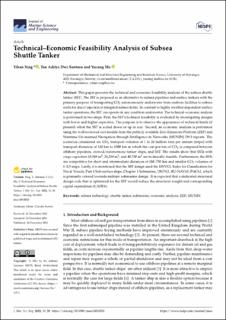| dc.contributor.author | Xing, Yihan | |
| dc.contributor.author | Santoso, Tan Aditya Dwi | |
| dc.contributor.author | Ma, Yucong | |
| dc.date.accessioned | 2023-01-23T08:24:05Z | |
| dc.date.available | 2023-01-23T08:24:05Z | |
| dc.date.created | 2021-12-27T11:12:03Z | |
| dc.date.issued | 2022 | |
| dc.identifier.citation | Xing, Y., Santoso, T. A. D., & Ma, Y. (2022). Technical–economic feasibility analysis of subsea shuttle tanker. Journal of Marine Science and Engineering, 10(1), 20. | en_US |
| dc.identifier.issn | 2077-1312 | |
| dc.identifier.uri | https://hdl.handle.net/11250/3045136 | |
| dc.description.abstract | This paper presents the technical and economic feasibility analysis of the subsea shuttle tanker (SST). The SST is proposed as an alternative to subsea pipelines and surface tankers with the primary purpose of transporting CO2 autonomously underwater from onshore facilities to subsea wells for direct injection at marginal subsea fields. In contrast to highly weather-dependent surface tanker operations, the SST can operate in any condition underwater. The technical–economic analysis is performed in two steps. First, the SST’s technical feasibility is evaluated by investigating designs with lower and higher capacities. The purpose is to observe the appearance of technical limits (if present) when the SST is scaled down or up in size. Second, an economic analysis is performed using the well-reviewed cost models from the publicly available Zero Emissions Platform (ZEP) and Maritime Un-manned Navigation through Intelligence in Networks (MUNIN) D9.3 reports. The scenarios considered are CO2 transport volumes of 1 to 20 million tons per annum (mtpa) with transport distances of 180 km to 1500 km in which the cost per ton of CO2 is compared between offshore pipelines, crewed/autonomous tanker ships, and SST. The results show that SSTs with cargo capacities 10,569 m3, 23,239 m3, and 40,730 m3 are technically feasible. Furthermore, the SSTs are competitive for short and intermediate distances of 180–750 km and smaller CO2 volumes of 1–2.5 mtpa. Lastly, it is mentioned that the SST design used the DNVGL Rules for Classification for Naval Vessels, Part 4 Sub-surface ships, Chapter 1 Submarine, DNVGL-RU-NAVAL-Pt4Ch1, which is primarily catered towards military submarine design. It is expected that a dedicated structural design code that is optimized for the SST would reduce the structural weight and corresponding capital expenditure (CAPEX). | en_US |
| dc.language.iso | eng | en_US |
| dc.publisher | MDPI | en_US |
| dc.rights | Navngivelse 4.0 Internasjonal | * |
| dc.rights.uri | http://creativecommons.org/licenses/by/4.0/deed.no | * |
| dc.title | Technical–Economic Feasibility Analysis of Subsea Shuttle Tanker | en_US |
| dc.title.alternative | Technical–Economic Feasibility Analysis of Subsea Shuttle Tanker | en_US |
| dc.type | Peer reviewed | en_US |
| dc.type | Journal article | en_US |
| dc.description.version | publishedVersion | en_US |
| dc.rights.holder | The author | en_US |
| dc.subject.nsi | VDP::Teknologi: 500 | en_US |
| dc.source.volume | 10 | en_US |
| dc.source.journal | Journal of Marine Science and Engineering | en_US |
| dc.source.issue | 1 | en_US |
| dc.identifier.doi | 10.3390/jmse10010020 | |
| dc.identifier.cristin | 1972163 | |
| cristin.ispublished | true | |
| cristin.fulltext | original | |
| cristin.qualitycode | 1 | |

